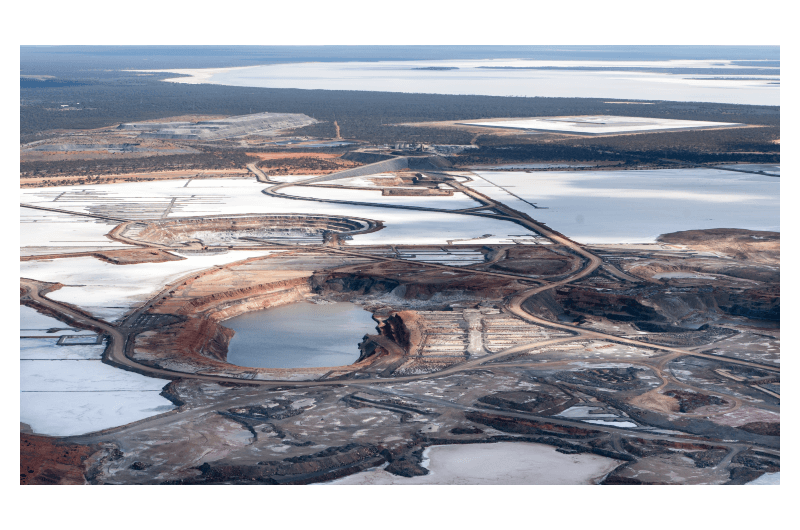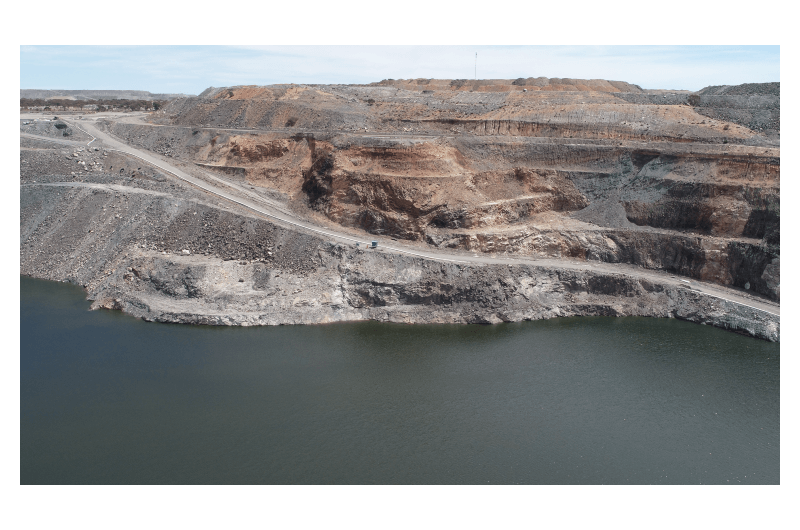St Ives Gold Mining Co
Key achievements
- Reduced scheme water use by
- Reduced operation costs
- Promoted a culture of sustainability
St Ives Gold Mining Co in Kambalda, in the Eastern Goldfields of WA, is a leading gold producer in Australia. Gold mining requires a significant amount of water use. Water is used for operations above and below ground, with one very important process separating gold from the rock.
The Mill (our processing plant) uses approximately 600,000L of water per day in these processes. Our water demand has also multiplied in recent years due to increased mining operations.
Our challenge – is to ensure an ongoing supply of sustainable water for the life of the mine.

Kambalda site aerial.
Searching for alternative solutions
To reduce our reliance on scheme water, we looked for new water sources and ways to reuse water. Not doing anything would lead to the inability to continue or expand operations, as water demand would outweigh supply.
Water is used in various work areas, including underground paste creation, gold extraction at the mill, exploration drilling, dust suppression, and many others. Using scheme water for all these activities would waste a valuable resource and come at an incredibly high cost. Instead, scheme water can be allocated where it is most needed by finding alternative supplies and reusing water, so lower-quality water can be used when possible.
Significant reductions
By improving our technology, moving to water-efficient practices and sourcing alternative water sources where possible, we reduced our scheme water use by 50%.
“St Ives is limited in its water options due to the high salinity of surrounding water sources – in some cases, the water available at St Ives is 10x saltier than seawater. This has led to a culture of valuing water and seeking to reuse water and seek alternative sources wherever possible.
“Aside from the environmental benefits, the sustainable use of water in our workplace makes good business sense because it reduces our operating costs. It demonstrates our commitment to creating enduring value beyond mining by conserving an extremely valuable natural resource.” – Bevan Jones, St Ives’ General Manager.
How we did it
We're always looking for ways to carry out our operations more efficiently, at a lower cost, and in ways that are better for the environment. Our Business Improvement Team helps individuals across all work areas to investigate and implement measures that improve efficiency – one of which is the improved pump technology in the processing plant.
The Projects and Infrastructure Team manages the bore fields and runs ongoing investigations into how to preserve and extend our bore field resources. The Water Strategy Group meets monthly to discuss ways to reduce scheme water use.
Understanding how important water is to gold mining operations and the region as a whole drives us to constantly look for ways to use water more efficiently.
Improved pump technology
Due to the fluctuating availability of freshwater from the stormwater catchment, the processing plant used an increasing amount of scheme water. Investigations were carried out in 2020 to see where water could be saved. It was identified that slurry pumps used around 47,000KL of water per year.
The processing plant has 9 pumps, 5 of which are in constant operation. On average, they were using 80L of water per minute. If the pumps operate without gland water (the water used in the pump) for even a few seconds, slurry from the Mill will flow back into the pump, damaging it and causing it to fail.
Water use dropped significantly by installing a different mechanism in the pump that expelled the slurry rather than washing it away. There are 3 different types of pumps in the processing plant:
- water use in the tails pump was reduced by 70%
- water use in the cyanide destruct pump reduced by 78%
- water use in the cyclone feed pump was reduced by 39%
This provided an overall reduction in annual water use of 50% for the processing plant pumps.
A trial is now in place to replace the cyclone feed pump with a model that does not require constant water use. If successful, there could be the opportunity to use this type of pump for tails and thickener pumps.
Replacing old wash bay & water reuse
The wash bay at the entrance to St Ives was replaced in 2021 with a more water-efficient model. This has reduced the amount of water we use per vehicle. We also started repurposing the water used at the wash bay by funnelling it into the nearby standpipe to be reused for drilling and dust suppression on roads. Previously, the water was being drained into an evaporation pond.
In July 2022, 421kL of water was reused from the wash bay pond, which increased to 867kL in August. These totals will fluctuate throughout the year, with increased use of the wash bay in winter due to muddy conditions.
Using stormwater
We’re constantly looking at ways to use other water sources to reduce our scheme of water use. We’ve been using Moorebah Dam for several years as an alternative to scheme water. It’s a stormwater catchment, so the amount of available water varies depending on rainfall. In 2020, it provided over 130,000kL of fresh water and around 100,000kL in 2021.
We also rely heavily on decanted water from Leviathan – a former open pit mine that was converted into a tailings storage facility (TSF). When the tailings reach Leviathan, they’re a slurry mixture with traces of cyanide. The tailings slowly fill up the pit and eventually dry out over time. However, Leviathan has a steady inflow of groundwater, and the pit is filling up faster than projected. This reduces the life of the TSF and does not allow the tailings to dry out.
In 2021, our metallurgy team tested whether the water from Leviathan could be used in the Mill to solve the problem of tailings storage and create another water source. The tests proved successful and additional pipelines and pumps were installed to return the water from Leviathan to the Mill. This further reduces pressure on scheme water.

Kambalda Leviathan.
Using bore field water to create paste
Underground mining uses paste – a mixture of tailings and water, to provide support and stability in the tunnels and backfill voids created by removing ore. Paste creation is the main water requirement for underground mining at St Ives; we have always used scheme water for this. On average, Invincible Underground mine (one of our two underground mines) uses 16.5 million litres of water per month to make paste.
Testing was carried out by our geotechnical team in 2021 to determine whether bore field water would be effective in producing the paste. Optimal conditions required the paste to set quickly and provide the required structural integrity underground – and it was a success. As a result, our paste plants are now using bore field water instead of scheme water.

Kambalda Fenton paste plant.
Educating our people
Following a risk assessment of water operations in 2021, we identified a lack of information on the importance of saving water in our operational and health and safety induction information for all Goldfields staff, contractors and visitors who access the site. Information about the types of water we use and the importance of reporting all water leaks have now been included.
Our Environment Team also runs a training course focusing on water use at the site. Staff are made aware of the legal requirements around monitoring water levels, water quality and what certain types of water can be used on site. All staff are encouraged to report water leaks if they see them around the site.
Tracking & reporting our water use
We’re part of the Global Reporting Initiative (GRI), an independent, international organisation that reports on the sustainability of businesses worldwide. One aspect of the GRI reporting is water usage. Each month we report on the total withdrawal of water (surface, ground and scheme), total water reused and the amount of wastewater discharge. Reporting on these metrics provides visibility of our ongoing commitment towards sustainable water use.

Shane Lee, Superintendent – Infrastructure and Rachelle Desmond, Advisor - Environment use water monitoring software to report on water use.
What we’re doing now
With different mining operations having different water requirements, projecting future water use is a complicated task requiring significant input and modelling. Collaboration across the business is key to ensuring water is used as efficiently and effectively as possible. We have established a separate working group to ensure water remains available throughout the projected life of the mine.
Our Water Strategy Group, comprised of different areas of the business, meet monthly to discuss current and future water use – and ensure water is being used efficiently. We have also set the following targets for 2030:
- Reduce freshwater (scheme water and stormwater) use by 45% (on the 2018 baseline)
- Recycle or reuse 80% of water